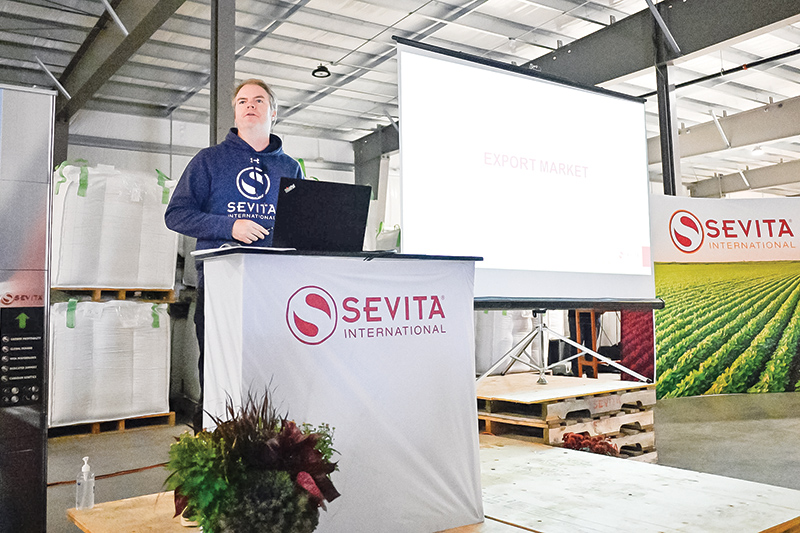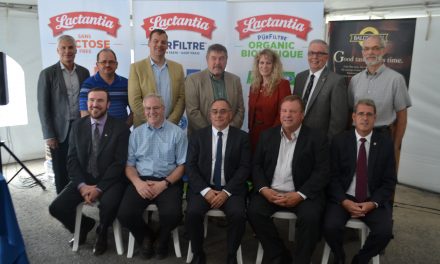John Hendrick, Export Manager for Sevita, spoke to the importance of the Japanese market and their preference for Canadian Soybeans. Tinkess Photo
INKERMAN – On Feb. 22, 2024, a fire levelled a large portion of Sevita’s soybean processing facility on Sandy Row in Inkerman, Ontario. Slightly more than six months later, on Wed., Sept. 4, the company welcomed members of the agriculture community to a “soybean social and BBQ” and offered an opportunity to look around the site, hear what the company’s plans are going forward and learn a bit more about the current situation for the world soybean market.
Kyle Smith, part of the southwestern Ontario team acted as master of ceremonies and got things started with a preview of what the day would hold. “There’s no better growers than Canadian soybean growers, and in our minds, that rings true,” said Smith. “We recently had a visit from the Kikkoman group, one of our buyers over in Japan, and you’ll hear John Hendricks talk about that, but they speak highly of Canadian soybean growers, but they speak very highly of the Sevita soybean growers that are growing soybeans for us. We truly appreciate your efforts in the fields, your attention to detail and getting, quality off so that we have a quality product to sell to our group in Japan.”
After the leading members of the Sevita team were introduced, Bob Hart, one of the founding members of the company addressed the audience about the fire and what Sevita’s plans were going forward.
Hart described that things in Inkerman were going smoothly, at least until he got a call around 5:00 a.m. from the Station Chief of the South Mountain (Township of North Dundas) fire department telling him that his shed was on fire. He described how, wakened from a deep sleep it had taken him a minute to understand what he was being told, but once that sunk in, he got in his truck and headed to Inkerman, arriving around 10:00 a.m.
“It was a total loss, obviously, of the plant itself,” said Hart. “It was a mess. It was packaged soybeans that were in the warehouse part. Here’s a pile here from the one bin was burning inside the bin, and we had to rip the side of the bin to let the stuff out so they could get the fire out.”
Hart gave a lot of credit and thanks to the volunteer firefighters who attended the fire. “They were awesome. They really were. They’re very, very professional. They really looked after stuff. I think they had to come back four times, but by the time they finally got it out. So, you get a big pile of soybeans burning, it took a lot of water.
“I can see the pump shed over there that, behind that, there’s a 70,000-gallon water reservoir for firefighting, which I thought was a waste of money when we put it in. And obviously we needed it. I think by the time they were done, they brought in about 350,000 gallons of water in their trucks. They pumped out of the river and brought it in.”
Hart said he is often asked what the cause of the fire was, but it has never been determined. “When the firemen got here, the building was pretty much on the ground. So, it was over, and the excavator they had rooting through it the whole time they were fighting, digging out hot spots, so by the time they were done, they totally rearranged everything. The Fire Marshall saw some pictures and didn’t even bother to come out to try to figure it out. Insurance did send out an investigator who spent five or six hours searching around and came out and said he had no idea what would have caused it.”
Hart told the audience that he is working with an engineer in Calgary who is designing the new facility. “The plan is to have all the concrete work done this fall before freeze-up,” said Hart. “The building is arriving in November, so we’re hoping to have the building up and kind of closed in January or February, and the equipment’s all ordered.”
Next to speak was John Hendrick, Sevita’s export manager, who spoke about the importance of the Japanese market to soybean producers.
“Japan is representing roughly 75 to 80 per cent of our total exports every year, depending on the harvest that we have here in Canada,” said Hendrick, “That is followed by China, which has been a good market for us, I’d say the last three or four years, very much different than Japan. Japan will always contract their beans a year in advance, so you really have a good understanding of what you need to go after and the different types of varieties that you need.
“The Chinese market, it’s a little bit more volatile. You don’t know what they’re going to need from one year to the next, but when they do step up, they buy big quantities, and they ship it very quickly. The Taiwanese or Taiwan is our third largest export market today, followed by Southeast Asia, South Korea, and we’re just starting to do a little business in the UK, and we do a little bit of business here at domestic level.”
Hendrick made a point of explaining how well thought of Canadian soybeans are in the world market. “Did you know that Canada is the second largest exporter of soybeans to Japan, the US being number one” asked Hendrick. “And having said that, did you know that the Japanese actually prefer Canadian quality versus the US?
“You know, we can grow high protein beans. We have consistent high protein profiles here in Canada, we’re also actively developing new non-GM food grade varieties for the Japanese market. And the US just isn’t doing that. They don’t have the same protein levels as us. Sure, they send a whole lot of product to Japan. But if you’re comparing quality, the Japanese always pick Canada as number one.”
The next speaker was Bailey Elchinger, an Ohio farmer, commodity markets and risk expert and Marketing Manager for Stonex Financial, who spoke about both the corn and soybean markets and her guiding principle that you must do something. She used a lot of current market information in her presentation, but perhaps the strongest message came at it’s conclusion.
“So, I like to always end this with talking a little bit about emotions,” said Elchinger. “It doesn’t feel good, right? I wish I had a better story. Trust me, I wish I could come up here and be like, guys don’t sell a thing. Corn is going to six bucks. Beans are going back to $12. Just hold on. I’ve never once given that speech in my career. I don’t know that I ever will, but someday I would love to be able to be the bearer of great news to all of you. But I don’t believe that that would be true to my title, and my title is risk management.”
Elchinger explained that you must manage your risk. “We’ve got to manage our risk. Your risk isn’t not selling today and the market goes up, your risk is not selling and the market goes down.
“Prediction is very difficult, especially if it’s about the future, but it’s okay,” said Elchinger. “We make our habits, and then our habits make us, so a quick review of Cal’s rules of grain marketing. He’s a bit of a living legend, so a quick review of those.
Number one, the current grain market is always correct.
Number two, set goals, make a marketing plan and stick them in.
Number three, the sooner I can turn my grain into cash for a profit, the better off I am.
Number four, the world does not care if I, as an individual, ever sell my grain.
“It’s blunt, but it’s true. A rallying market should be rewarded. I should market my grain because of a good price or profit, not because of a lack of time or money. Don’t say woulda, coulda, shoulda, say I did, and don’t look back.”
Elchinger said it is better to sell a day too early than a day too late, because the market will never wait for you to make up your mind. And lastly, when you know that the market must go up and you’re going to hold on to it until it does, refer to rule number one. You must ask yourself, what’s going to cause you to lose more sleep at night, selling today, and the price goes up or not selling, and the price goes down?
“Do something,” said Elchinger. “Do something, don’t be that guy. We don’t determine our future, we determine our habits, and our habits determine our future. So, if you say my habit is I sell my corn off the combine, because that’s how dad did it, it’s how Grandad did it, and that’s what I always do.
“So, we looked at the December corn futures average price from April 15 to June 15. We compared that average to the October 1 price, just as futures, US dollars, no currency impact, all those things, right? Thirteen of the last seventeen years, the average from April to June was higher than the Oct. 1 price.
Seventy-five per cent of the time, the average in the summer was higher than the October 1 price.
“You can’t just store it, ignore it,” said Elchinger. “Okay, so you’re saying, If I don’t sell my corn, ahead of harvest, I should just sell it off the combine. No, not necessarily. But what I am saying is that if you wait until after harvest to market your corn 70% of the time your best marketing opportunity is behind you. Your best opportunity is behind you.
Following a few prize draws and award presentations the group broke for lunch, barbeque served buffet style, and then had a chance to tour the facility before heading back to work.
It has been quite a year for Sevita, one, in many ways they hope will never happen again. They have, however proven they can literally rise from the ashes, and look forward to what the future will bring.













